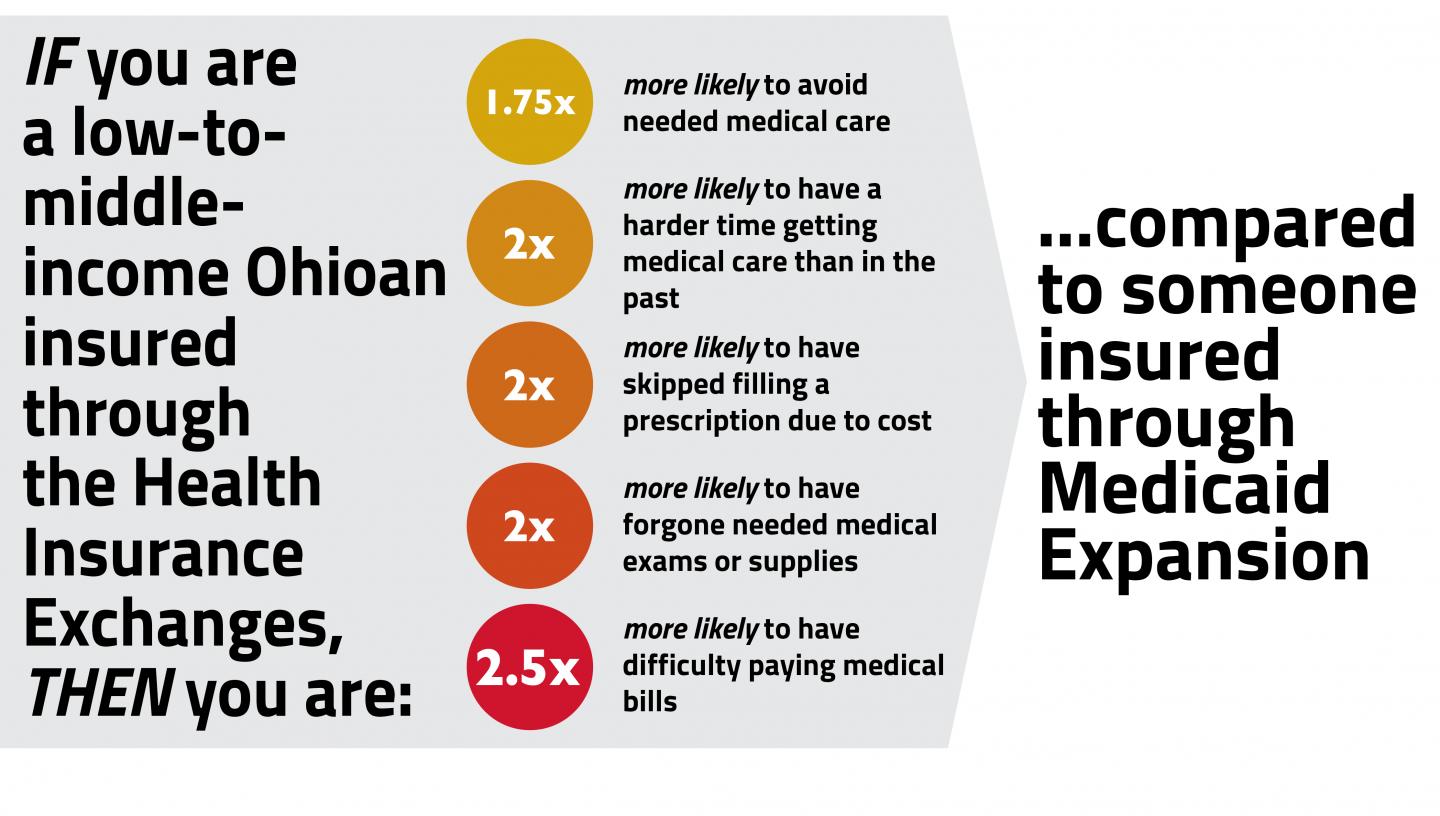For subsidized Ohio health-exchange users, high out-of-pocket costs often mean bypassed care compared to Medicaid recipients

Credit: Case Western Reserve University School of Medicine
Because of high out-of-pocket expenses, Ohioans who purchase subsidized health-exchange insurance often can’t afford the care they need when they need it. That is a central finding of a new study from researchers at Case Western Reserve University School of Medicine.
Examining a total of nearly 43,000 Ohio adults, the researchers found that low- to middle- income individuals who received subsidies to purchase insurance through health-insurance exchanges established under the Affordable Care Act were significantly more likely to experience problems with access and affordability, such as skipping doctor’s visits and not filling prescriptions, than those insured through Medicaid expansion generated by passage of the ACA.
“High out-of-pocket costs associated with exchange health plans often mean that those who don’t qualify for Medicaid face significant barriers to accessing affordable care,” said the study’s senior author, Siran Koroukian, PhD, associate professor in the Department of Population and Quantitative Health Sciences. “As a result, they delay or omit needed care; and the likely scenario is that they become sicker before they eventually qualify for Medicaid. This creates a paradox: they formally have insurance, but because they can’t afford the high deductibles and co-pays, they may be worse off medically than those without insurance or who receive Medicaid, which has nominal co-expenses.”
In the study, newly published in the Journal of General Internal Medicine, the researchers compared measures of access and affordability between Medicaid recipients in Ohio (an expansion state) and low/middle-income Ohioans whose incomes were high enough to disqualify them for Medicaid but low enough to qualify them for health insurance exchange subsidies. They found that, compared to Medicaid recipients, exchange patients were:
- 2.5 times more likely to have difficulty paying medical bills
- 2 times more likely to have foregone needed medical exams or supplies
- 2 times more likely to have skipped filling a prescription because of high cost
- 2 times more likely to have had a harder time getting medical care than in the past
- 1.75 times more likely to avoid needed medical care
“We know that ACA has insured more people, which was its intent, but there is work to be done in making that insurance more effective in getting care for low- and middle-income people,” said the study’s lead author, Uriel Kim, an MD/PhD student in the School of Medicine. “Typically we think of Medicaid recipients as more vulnerable than those with private insurance. But in reality, Medicaid expansion has gone well because it is meeting its goal of increasing access to affordable care for its users. At the same time, relatively high out-of-pocket expenses mean that some recipients who use exchanges are choosing to go without care, which in the long run makes them sicker – even having to turn to Medicaid to get the care they need.”
Individuals in states that expanded Medicaid eligibility under the Affordable Care Act are eligible for Medicaid if their income is less than 138 percent of the federal poverty level. Above this threshold, those with incomes up to 400 percent of the federal poverty level can receive sliding-scale subsidies to offset premium costs for insurance purchased on health exchanges. These subsidies vary by the insurance metal level and, for silver plans only, by the consumer’s income. Bronze, silver, gold, and platinum plans have actuarial values (the percentage of health care costs the plans are designed to pay) of 60 percent, 70 percent, 80 percent, and 90 percent respectively. Silver Plans additionally offer subsidies to offset patients’ out-of-pocket costs at the time of care for those with incomes up to 250 percent of the federal poverty level.
In Ohio, only 70 percent of eligible individuals take advantage of cost-sharing reductions available for silver plans; 28 percent enroll in bronze. By forgoing silver plans in favor of outwardly less expensive bronze plans, enrollees in this income group often unexpectedly are confronted with high out-of-pocket costs, the researchers found.
“There are two notions of affordability when it comes to purchasing health care: the cost of insurance and the out-of-pocket costs someone pays when they seek care,” said the study’s third author, Johnie Rose, MD, PhD, assistant professor of family medicine. “Policymakers should carefully evaluate whether current income-based, cost-sharing reductions for silver plans adequately remove barriers to receiving care and whether enrollees sufficiently understand cost-sharing differences across the exchange plans.”
One implication of the study’s findings is that increasing Affordable Care Act cost-sharing subsides or raising the income threshold for Medicaid eligibility would expand accessibility. “Either way, this would ultimately save taxpayers money by keeping people healthier and not forcing them into financial toxicity,” said Koroukian. “This is especially true in expensive cases such as cancer. Higher out-of-pocket expenses can result in delays in getting cancer tests, resulting in later-stage diagnoses, sicker patients, greater expenditures, and often poorer patient outcomes.”
###
Funding for the study was supported by the National Institutes of Health, Centers for Disease Control and Prevention, Pharmaceutical Research and Manufacturers of America Foundation, CWRU Center for Community Health Integration, University Hospitals Cleveland Medical Center Department of Family Medicine and Community Health, American Cancer Society, CWRU Center for Reducing Health Disparities, Ohio Medicaid Technical Assistance and Policy Program, Cleveland Clinic Foundation, and Celgene Corporation.
Kim, U., et al. “Access and Affordability in Low- to Middle-Income Individuals
Insured Through Health Insurance Exchange Plans: Analysis of Statewide Data.” Journal of General Internal Medicine. DOI: 10.1007/s11606-019-04826-w
For more information about Case Western Reserve University School of Medicine, please visit case.edu/medicine.
Media Contact
Ansley Gogol
[email protected]
Related Journal Article
http://dx.




